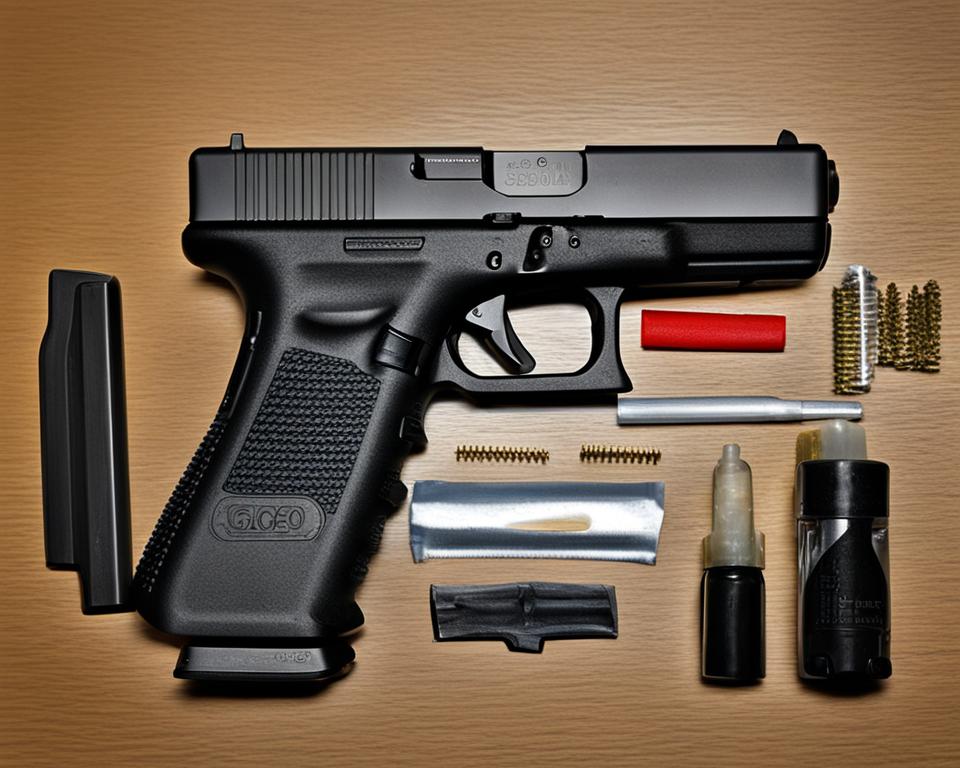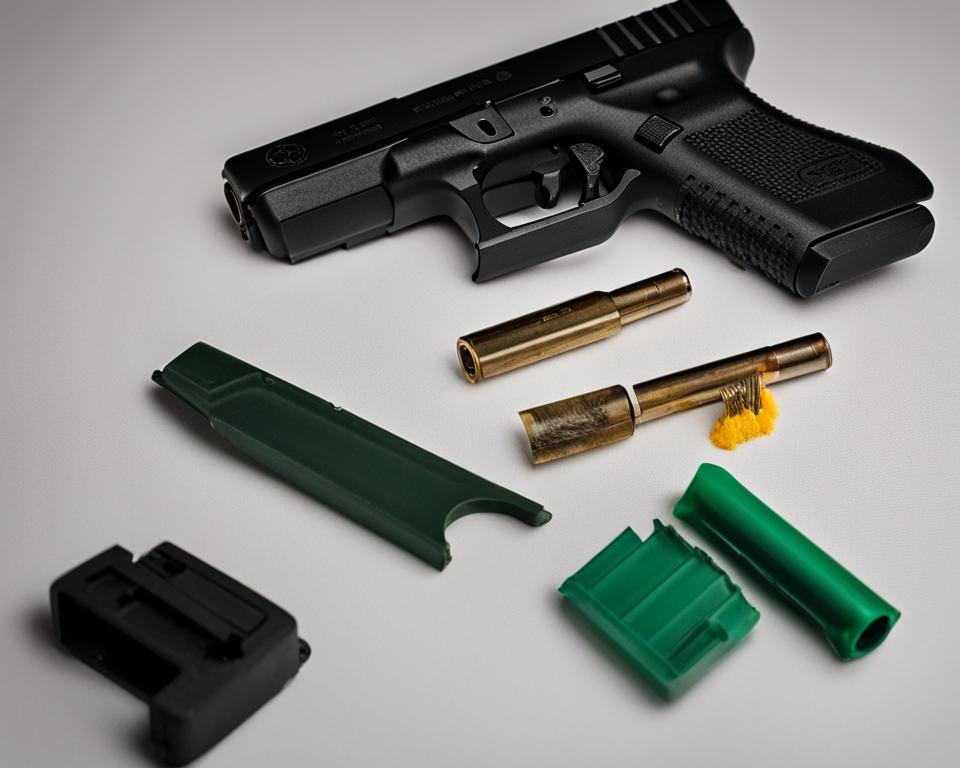Properly maintaining your Glock 30 is crucial for keeping it reliable and ensuring its longevity. Neglecting maintenance can lead to failures to fire and eject. This article will provide you with expert tips on how to clean your Glock 30 effectively, as well as some general guidelines for maintaining other striker-fired pistols.
Key Takeaways:
- Cleaning your Glock 30 regularly is important for its reliability and longevity.
- Follow a step-by-step guide to properly clean your Glock 30, focusing on the barrel, slide, frame, recoil spring assembly, and magazines.
- Adhere to best practices for Glock 30 maintenance, such as cleaning after every use, using approved cleaning products, and regular inspection.
- Pay attention to the specific cleaning needs of Polymer 80 Glocks and high round count Glocks.
- Seek expert advice and continuously educate yourself on Glock maintenance techniques.
Why Cleaning Your Glock 30 is Important
Regular cleaning and maintenance of your Glock 30 are important for several key reasons. Poor maintenance can result in malfunctions and failures that could compromise your safety. By keeping your Glock 30 clean, you can enhance its reliability and ensure that it functions properly every time you need it. Additionally, cleaning your Glock 30 helps prevent the buildup of dirt, carbon, and other fouling agents that can affect its performance.
Proper maintenance and cleaning of your Glock 30 can significantly contribute to its longevity. Regular cleaning not only removes dirt and debris but also helps prevent rust and corrosion from developing on the internal and external surfaces of the firearm. By taking the time to clean your Glock 30 after each use, you can protect its metal components and extend its lifespan.
The benefits of regular maintenance for your Glock 30 are not limited to performance and longevity. Cleaning your Glock 30 also allows you to inspect its various parts and ensure they are in proper working condition. During the cleaning process, you can identify any potential issues such as worn-out components or loose connections. Detecting and addressing these issues early can prevent more significant problems down the line and save you from potential malfunctions or failures.
Table 1: Benefits of Regular Maintenance for Glock 30
| Benefits | Description |
|---|---|
| Enhanced Reliability | Cleaning your Glock 30 ensures consistent and reliable performance. |
| Extended Lifespan | Regular maintenance helps prevent premature wear and extends the life of your Glock 30. |
| Preventive Maintenance | Cleaning allows for inspection and early identification of potential issues, preventing malfunctions. |
| Corrosion Prevention | Regular cleaning protects the firearm’s metal surfaces from rust and corrosion. |
In conclusion, cleaning your Glock 30 is of utmost importance to ensure its reliable function, longevity, and overall performance. Regular maintenance allows you to inspect the firearm for any potential issues and prevent malfunctions. By dedicating time to clean and care for your Glock 30, you can enjoy the benefits of a reliable and durable firearm for years to come.
Step-by-Step Guide for Cleaning Your Glock 30
Properly cleaning your Glock 30 is essential for maintaining its reliability and performance. Follow this step-by-step guide to ensure your Glock 30 remains in optimal condition:
1. Read the owner’s manual:
Start by familiarizing yourself with the manufacturer’s recommendations for disassembling, cleaning, and reassembling your Glock 30. The owner’s manual will provide specific instructions tailored to your firearm.
2. Safety first:
Always prioritize safety when handling firearms. Before beginning the cleaning process, ensure your Glock 30 is unloaded and cleared, following proper firearms safety rules.
3. Prepare your cleaning supplies:
Gather all the necessary cleaning supplies, including solvent, patches, a toothbrush, a dry cloth, and any other cleaning tools you prefer to use. Having everything prepared beforehand will streamline the cleaning process.
4. Field strip your Glock 30:
Disassemble your Glock 30 according to the instructions provided in the owner’s manual. This typically involves removing the slide, barrel, recoil spring assembly, and frame components.
5. Clean the barrel:
Using a solvent-soaked patch, run it through the chamber and bore of the barrel multiple times to remove any fouling. Use a toothbrush to scrub the interior surfaces, ensuring the feed ramp is clean and shiny.
6. Clean the slide:
Wipe the interior of the slide with a dry patch or cloth to remove any residue. Use a toothbrush and solvent to scrub the breech face and slide rails, ensuring all components are free from debris.
7. Clean the frame:
Wipe down the exterior of the frame and use a toothbrush and solvent to clean the carbon and fouling from the interior. Pay close attention to the rails, trigger bar, and connector area.
8. Clean the recoil spring assembly:
Wipe down the recoil spring assembly to remove any dirt or debris that may have accumulated. Ensure it is clean and functioning properly.
9. Clean the magazines:
Wipe the exterior of the magazines and clean the follower and feed lips to ensure proper feeding of ammunition. Inspect the magazines for any signs of damage or wear.
10. Reassemble your Glock 30:
Dry all the components thoroughly and apply lubrication sparingly to the necessary areas. Follow the manufacturer’s instructions to reassemble your Glock 30, ensuring all parts are properly reinstalled.
By following these step-by-step instructions, you can effectively clean your Glock 30 and maintain its reliability and longevity.
Best Practices for Glock 30 Maintenance
Proper Glock 30 cleaning techniques and maintenance practices are essential for preserving the performance and reliability of your firearm. By following these best practices, you can ensure that your Glock 30 functions flawlessly every time you need it.
Regular Cleaning Schedule
One of the most important best practices is to establish a regular cleaning schedule for your Glock 30. Cleaning your firearm after every use, particularly after range sessions or exposure to dirt and moisture, is crucial. Regular cleaning helps prevent the buildup of dirt, carbon, and other fouling agents that can affect the pistol’s performance.
Use Quality Cleaning Products
When cleaning your Glock 30, it is vital to use high-quality cleaning solvents, lubricants, and tools specifically designed for firearms. These products are formulated to effectively remove fouling agents while protecting the internal components of your Glock 30.
Inspect for Wear and Damage
Regularly inspect your Glock 30 for any signs of wear, stress, or damage. Pay close attention to components such as the recoil spring assembly and trigger spring, as these parts may require replacement at recommended intervals. Promptly address any issues you identify to prevent further damage and maintain the longevity of your Glock 30.
Store Properly
Proper storage is crucial for maintaining the condition of your Glock 30. Store your firearm in a clean and dry environment, preferably in a gun safe or case, to protect it from dust, moisture, and potential damage. Storing your Glock 30 correctly ensures that it remains in optimal condition between uses.
| Best Practices for Glock 30 Maintenance | |
|---|---|
| Establish a regular cleaning schedule | Clean after every use, particularly after exposure to dirt and moisture |
| Use high-quality cleaning products | Invest in cleaning solvents, lubricants, and tools designed specifically for firearms |
| Inspect for wear and damage | Regularly check for signs of wear, stress, or damage, especially in components like recoil spring assembly and trigger spring |
| Store properly | Keep your Glock 30 in a clean and dry environment, preferably in a gun safe or case |
Cleaning Tips for Polymer 80 Glocks
If you own a Polymer 80 Glock, proper cleaning and maintenance are essential to ensure its optimal performance and longevity. While the cleaning process is similar to that of a traditional Glock, there are some specific considerations to keep in mind for Polymer 80 frames. Let’s explore some expert cleaning tips to help you maintain your Polymer 80 Glock.
Step-by-Step Cleaning Guide for Polymer 80 Glocks
Follow these step-by-step instructions to effectively clean your Polymer 80 Glock:
- Begin by ensuring your Glock is unloaded and cleared of any ammunition.
- Disassemble your Polymer 80 Glock according to the manufacturer’s instructions.
- Using a clean cloth or patch, wipe down the frame and remove any visible dirt or debris.
- Clean the rails and trigger bar area using a small brush or toothbrush. Pay close attention to the trigger mechanism.
- Inspect the frame for any signs of stress, cracks, or damage. Polymer 80 frames may be more prone to wear, so it’s important to check for any issues.
- Clean the barrel, slide, and other components following the same cleaning steps outlined for a traditional Glock.
- Once all the components are clean and dry, reassemble your Polymer 80 Glock according to the manufacturer’s instructions.
By following these cleaning tips, you can ensure that your Polymer 80 Glock remains in top condition and functions reliably when you need it. Regular maintenance is crucial for any firearm, and Polymer 80 Glocks are no exception.

Table: Recommended Cleaning Products
| Product | Description |
|---|---|
| Glock OEM Cleaning Kit | A complete cleaning kit designed specifically for Glock pistols, including brushes, rods, and solvents. |
| Hoppe’s Elite Gun Cleaner | A high-quality gun cleaner that effectively removes carbon, lead, and other fouling agents. |
| Break-Free CLP | An all-in-one cleaner, lubricant, and protectant that helps prevent corrosion and ensures smooth functioning. |
| Ballistol Multi-Purpose Oil | A versatile oil suitable for cleaning, lubricating, and protecting firearms. It is safe to use on polymer frames. |
These cleaning products are recommended by experts and widely used by firearm enthusiasts. However, always refer to the manufacturer’s recommendations and instructions when choosing cleaning products for your Polymer 80 Glock.
Maintaining a High Round Count Glock
When it comes to owning a Glock with a high round count, proper maintenance is key to ensuring its longevity and continued reliability. These pistols are known for their durability and ability to withstand extensive use, but taking the necessary steps to care for your high round count Glock will help maximize its performance and lifespan.
Regular Cleaning
A high round count Glock is more prone to carbon buildup and fouling, which can negatively impact its function. Therefore, it is essential to clean your Glock thoroughly after each range session or whenever it becomes exposed to dirt, mud, or water. Pay close attention to the barrel, slide, frame, and other components, ensuring that all dirt and debris are removed.
Additionally, be diligent about inspecting and cleaning the recoil spring assembly. Over time, the recoil spring may lose its tension, affecting the overall function of the pistol. Regularly check for signs of wear and replace the recoil spring at recommended intervals to maintain optimal performance.
Replacement of Worn Components
A high round count Glock may experience accelerated wear on certain components, such as the trigger spring and slide rails. It is crucial to keep track of your round counts and replace these worn parts as needed. By replacing these components proactively, you can prevent potential malfunctions or failures that could compromise the performance and safety of your Glock.
Furthermore, regularly inspect your high round count Glock for any signs of excessive wear or stress. Look for cracks, bulges, or other indications of wear that may require professional attention or replacement. Taking care of these issues promptly can help prolong the lifespan of your Glock and ensure its continued reliability.
| Component | Replacement Interval |
|---|---|
| Recoil Spring Assembly | Every 3,000 – 5,000 rounds |
| Trigger Spring | Every 7,000 – 10,000 rounds |
| Slide Rails | As needed, based on wear |
By following these maintenance practices, you can keep your high round count Glock in optimal condition, ensuring its reliability and longevity. Remember to consult your Glock’s owner’s manual for specific recommendations and guidelines, and don’t hesitate to seek professional assistance if you have any concerns or issues with your firearm.

Expert Tips for Glock Maintenance
When it comes to maintaining your Glock, following expert tips can ensure that your firearm remains in top condition. Here are some professional Glock cleaning advice:
1. Use quality cleaning products: To effectively clean your Glock, invest in high-quality solvents, lubricants, and tools specifically designed for firearms. These products are formulated to provide optimal cleaning without damaging the components of your Glock.
2. Maintain a cleaning schedule: Establish a regular cleaning schedule based on your Glock’s usage and round count. Regular cleaning will help prevent the buildup of carbon and other fouling agents, ensuring that your Glock functions reliably every time you need it.
3. Don’t over-lubricate: Applying too much lubrication can attract dirt and debris, potentially affecting the reliability of your Glock. Apply lubricant sparingly and wipe off any excess to retain optimal performance.
4. Seek professional assistance: If you encounter any issues or concerns with your Glock 30, don’t hesitate to consult a professional armorer or gunsmith for assistance. They have the expertise and knowledge to address any technical issues and ensure the proper functioning of your firearm.
5. Continuously educate yourself: Stay updated on the latest Glock maintenance recommendations and techniques. Manufacturers provide valuable resources that can help you understand the best practices for cleaning and maintaining your Glock. Additionally, reputable firearms publications and online forums are excellent sources for staying informed about Glock maintenance.
FAQ
Why is regular cleaning and maintenance important for a Glock 30?
Regular cleaning and maintenance ensure reliable performance, prevent malfunctions, and extend the longevity of your Glock 30.
How often should I clean my Glock 30?
Clean your Glock 30 after every use, especially after range sessions or exposure to dirt, mud, or water.
What cleaning products should I use for my Glock 30?
Use cleaning products specifically designed for firearms and follow the manufacturer’s recommendations.
How do I clean the barrel of my Glock 30?
Run a solvent-soaked patch through the chamber and bore multiple times, then use a toothbrush to scrub the interior surfaces. Ensure the feed ramp is clean and shiny.
How do I clean the slide of my Glock 30?
Wipe the interior of the slide with a dry patch or cloth, then use a toothbrush and solvent to scrub the interior surfaces, paying attention to the breech face and slide rails.
How do I clean the frame of my Glock 30?
Wipe down the exterior of the frame and clean the carbon and fouling from the interior, including the rails, trigger bar, and connector area.
How do I clean the magazines of my Glock 30?
Wipe the exterior of the magazines and clean the follower and feed lips to ensure proper feeding.
How do I reassemble my Glock 30 after cleaning?
Dry all components thoroughly, apply lubrication sparingly, and reassemble your Glock 30 according to the owner’s manual.
How should I store my Glock 30?
Store your Glock 30 in a clean and dry environment, preferably in a gun safe or case, to protect it from dust, moisture, and potential damage.
Is it necessary to seek professional assistance for Glock 30 maintenance?
If you encounter any issues or concerns, it is recommended to consult a professional armorer or gunsmith for assistance.

Leave a Reply